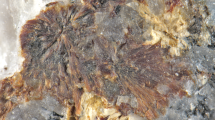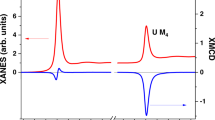Abstract
IN the course of investigations of the electronic absorption spectra of crystals of DNA bases, we have found that an unusual band appears in addition to the usual π → π* transition when the crystal has the  hydrogen bonding. This absorption band is observed in thymine monohydrate, thymine, uracil and 5-ethyl 6-methyl uracil crystals; however, it is not found in calcium thymidylate and barium uridylate1. In the former class of crystals, hydrogen bondings of the type
hydrogen bonding. This absorption band is observed in thymine monohydrate, thymine, uracil and 5-ethyl 6-methyl uracil crystals; however, it is not found in calcium thymidylate and barium uridylate1. In the former class of crystals, hydrogen bondings of the type  are present, while in the latter such bondings of the typeare present, while in the latter such bonding are not present, because the bases are separated from each other. Fig. 1a shows a typical absorption spectrum for a crystal of thymine monohydrate; for comparison, Fig. 2 shows the absorption spectrum of calcium thymidylate. Both compounds show similar absorption spectra in solution at about 2640 Å, and corresponding bands occur at about the 2600∼2750 Å region in all such crystals. The extra band at 2850 Å in thymine monohydrate crystals is considered to be a new type, because it is observed only in the particular crystalline state. It was possible to determine the direction of the transition moment of the 2650 Å band (π→π* transition) from the polarization measurement of all these crystals. It was found to be inclined at about 20° from the N1 - - - C4 line towards N3 atom (compare with Fig. 3). This result is nearly in agreement with the earlier results of Stewart and Davidson2 on 1-methyl thymine, who regarded this angle to be either 14° or −19°.
are present, while in the latter such bondings of the typeare present, while in the latter such bonding are not present, because the bases are separated from each other. Fig. 1a shows a typical absorption spectrum for a crystal of thymine monohydrate; for comparison, Fig. 2 shows the absorption spectrum of calcium thymidylate. Both compounds show similar absorption spectra in solution at about 2640 Å, and corresponding bands occur at about the 2600∼2750 Å region in all such crystals. The extra band at 2850 Å in thymine monohydrate crystals is considered to be a new type, because it is observed only in the particular crystalline state. It was possible to determine the direction of the transition moment of the 2650 Å band (π→π* transition) from the polarization measurement of all these crystals. It was found to be inclined at about 20° from the N1 - - - C4 line towards N3 atom (compare with Fig. 3). This result is nearly in agreement with the earlier results of Stewart and Davidson2 on 1-methyl thymine, who regarded this angle to be either 14° or −19°.
This is a preview of subscription content, access via your institution
Access options
Subscribe to this journal
Receive 51 print issues and online access
$199.00 per year
only $3.90 per issue
Buy this article
- Purchase on Springer Link
- Instant access to full article PDF
Prices may be subject to local taxes which are calculated during checkout
Similar content being viewed by others
References
Gerdil, R., Acta CrySt., 14, 333 (1961). Furbert, S., and Hordvik, A., Acta Chem. Scand., 10, 135 (1956). Parry, G. S., Acta Cryst., 7, 313 (1954). Reeke, jun., G. N., Acta Cryst., 20, 703 (1966). Trueblood, K. N., Horn, P., and Luzzati, V., Acta Cryst., 14, 965 (1961). Shefter, E., and Trueblood, K. N., Acta Cryst., 18, 1067 (1965).
Stewart, R. F., and Davidson, N., J. Chem. Phys., 39, 255 (1963).
Nukasawa, K., Tanaka, J., and Nagakura, S., J. Phys. Soc. Japan, 8, 792 (1963).
Tsubomura, H., Bull. Chem. Soc. Jap., 27, 445 (1954).
Coulson, C. A., and Danielsson, U., Arkiv.fur Fysik, 8, 239 and 245 (1954).
Nagakura, S., J. Chim. Phys., 61, 217 (1964).
Author information
Authors and Affiliations
Rights and permissions
About this article
Cite this article
TANAKA, J., TANAKA, M. Electronic Absorption Bands associated with the Hydrogen Bondings of Thymine and Uracil. Nature 213, 68–70 (1967). https://doi.org/10.1038/213068b0
Received:
Issue Date:
DOI: https://doi.org/10.1038/213068b0
Comments
By submitting a comment you agree to abide by our Terms and Community Guidelines. If you find something abusive or that does not comply with our terms or guidelines please flag it as inappropriate.



